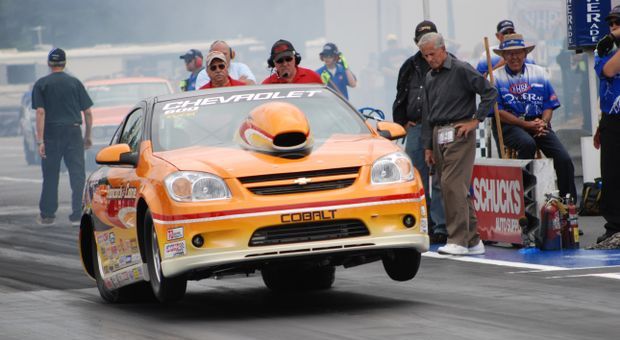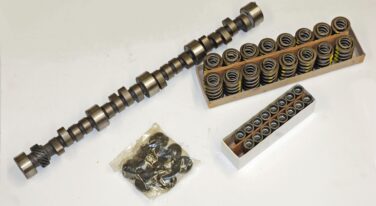
Going Quicker, Faster and More Reliably with Lightweight Hardware Part 1
Click Here to Begin Slideshow
It should be no secret to anyone who has ever climbed into a racecar that there’s more than one way to go fast. An easy method is to simply build more power. Sometimes, though, it’s more effective (and equally important, often more reliable) to shed pounds. Obviously, it’s no big secret that light is more than right when it comes to drag racing. But what might be more of a labyrinth is the effect of reducing unsprung and rotational mass (we’ll get to that in a bit). But once accomplished, the significance of removing weight from the driveline components in a racecar is considerable.
The big question is why in the world would a little-guy racer want to spend money on something you can’t see (lightweight rear end hardware)? Simple: It takes horsepower to accelerate mass. And the more excess flab you have, the harder it is to get it moving (this is sort of like eating too much Thanksgiving turkey and trying to roll off the couch - it takes plenty of effort). There's more here, too: All of the lightweight rear axle pieces we're going to show you in this article aren't really a reliability liability. In simple terms, they have the integral strength to handle whatever your engine combo can dish out. Finally, there's the consistency factor. In the writer’s opinion, light (and strong) is more consistent than heavy (and strong). Need an analogy? Try rolling off that same couch a couple of times when you're over-stuffed with grub. Now try the same thing when you're in good trim. We'll bet you can "repeat" the process much more easily when you're in shape.
Still not convinced? A number of successful sportsman chassis builders and racers have long been proponents of reducing rotating mass, especially in driveline components. For example, it’s not uncommon to find many NHRA Super Stock and Competition Eliminator cars (even some portly ones) fitted with lightweight drive train hardware. Not only do these racers run gun-drilled axles with scalloped flanges, they also use aluminum spools coupled with profile milled ring gears. Even in 3,000+ pound S/S cars, reliability has never been a factor. The lightweight pieces live and those class racers with the “good” parts quickly discovered the many advantages of racing with lightweight drive train components. You can too. Check out the following diet plan:
Axles: A set of lightened axles from Mark Williams can reduce weight by at least 9-1/2 pounds (depending upon the length of the axles and the type of rear end into which they're going). As an example, one standard M-W axle for a typical S/S car weighs 17.3 pounds. The same axle in a M-W Super-Light configuration weighs 12.4 pounds. How and where is axle weight reduced? The first place is a "gun" drilled axle. Using Mark Williams’ pieces as an example, the core of the axle shaft is bored 11/16-inch to resemble a gun barrel. As you can well imagine, this requires special machine tools, but M-W takes an extra step in the process (one seldom, if ever, done by other companies): They precision-hone the gun drill bore to remove tooling marks. Now, this might seem like a small step, but the honing process actually improves the strength of a gun-drilled axle. Whenever M-W gun drills an axle, they also include round lightening holes in the axle flange. These two steps reduce axle weight by 17% over a standard axle.
If you're extra-serious about reducing rear end flab, you can look at the Super-Light pieces we mentioned earlier. In this case, the gun drilled bore is increased to 7/8-inch (and, of course, honed). Additionally, the axle flanges are extensively milled. While you can't see it on a complete axle, there's also extensive machining behind the M-W nameplate at the end of the axle coupled with a revised axle profile. These machining operations can result in a weight savings of 29% over a standard gun drilled axle. Typically, this machining is done to 35 spline axles for use on cars up to 1800 pounds and on 40 spline axles for cars over 1800 pounds.
If cost is no object and you need the absolute ultimate in lightweight axles, then M-W’s “Ultimate 300M Hi-Torque” axles are the pieces to consider (they run roughly $400 more than the Super Light jobs). By using aircraft grade 300M forgings with higher tensile strength properties, a reduction in reciprocating weight is accomplished. These axles have the gun drilled bore enlarged to 1-inch coupled with extensive milling of the axle flanges. There is also additional machining behind the MW nameplate on the flange side of the axle, as well as a revised axle profile. This results in a weight savings of 36% over the standard gun drilled MW axles. FYI, these axles are available only in 40-spline configuration.
Next issue, we’ll take a closer look at weight savings measures, including lightweight spools, housings and even wheel backspace. Watch for it. There’s more here than you might have first thought.
Photos courtesy Mark Williams.
It should be no secret to anyone who has ever climbed into a racecar that there’s more than one way to go fast. An easy method is to simply build more power. Sometimes, though, it’s more effective (and equally important, often more reliable) to shed pounds. Obviously, it’s no big secret that light is more than right when it comes to drag racing. But what might be more of a labyrinth is the effect of reducing unsprung and rotational mass (we’ll get to that in a bit). But once accomplished, the significance of removing weight from the driveline components in a racecar is considerable.
The big question is why in the world would a little-guy racer want to spend money on something you can’t see (lightweight rear end hardware)? Simple: It takes horsepower to accelerate mass. And the more excess flab you have, the harder it is to get it moving (this is sort of like eating too much Thanksgiving turkey and trying to roll off the couch - it takes plenty of effort). There's more here, too: All of the lightweight rear axle pieces we're going to show you in this article aren't really a reliability liability. In simple terms, they have the integral strength to handle whatever your engine combo can dish out. Finally, there's the consistency factor. In the writer’s opinion, light (and strong) is more consistent than heavy (and strong). Need an analogy? Try rolling off that same couch a couple of times when you're over-stuffed with grub. Now try the same thing when you're in good trim. We'll bet you can "repeat" the process much more easily when you're in shape.
Still not convinced? A number of successful sportsman chassis builders and racers have long been proponents of reducing rotating mass, especially in driveline components. For example, it’s not uncommon to find many NHRA Super Stock and Competition Eliminator cars (even some portly ones) fitted with lightweight drive train hardware. Not only do these racers run gun-drilled axles with scalloped flanges, they also use aluminum spools coupled with profile milled ring gears. Even in 3,000+ pound S/S cars, reliability has never been a factor. The lightweight pieces live and those class racers with the “good” parts quickly discovered the many advantages of racing with lightweight drive train components. You can too. Check out the following diet plan:
Axles: A set of lightened axles from Mark Williams can reduce weight by at least 9-1/2 pounds (depending upon the length of the axles and the type of rear end into which they're going). As an example, one standard M-W axle for a typical S/S car weighs 17.3 pounds. The same axle in a M-W Super-Light configuration weighs 12.4 pounds. How and where is axle weight reduced? The first place is a "gun" drilled axle. Using Mark Williams’ pieces as an example, the core of the axle shaft is bored 11/16-inch to resemble a gun barrel. As you can well imagine, this requires special machine tools, but M-W takes an extra step in the process (one seldom, if ever, done by other companies): They precision-hone the gun drill bore to remove tooling marks. Now, this might seem like a small step, but the honing process actually improves the strength of a gun-drilled axle. Whenever M-W gun drills an axle, they also include round lightening holes in the axle flange. These two steps reduce axle weight by 17% over a standard axle.
If you're extra-serious about reducing rear end flab, you can look at the Super-Light pieces we mentioned earlier. In this case, the gun drilled bore is increased to 7/8-inch (and, of course, honed). Additionally, the axle flanges are extensively milled. While you can't see it on a complete axle, there's also extensive machining behind the M-W nameplate at the end of the axle coupled with a revised axle profile. These machining operations can result in a weight savings of 29% over a standard gun drilled axle. Typically, this machining is done to 35 spline axles for use on cars up to 1800 pounds and on 40 spline axles for cars over 1800 pounds.
If cost is no object and you need the absolute ultimate in lightweight axles, then M-W’s “Ultimate 300M Hi-Torque” axles are the pieces to consider (they run roughly $400 more than the Super Light jobs). By using aircraft grade 300M forgings with higher tensile strength properties, a reduction in reciprocating weight is accomplished. These axles have the gun drilled bore enlarged to 1-inch coupled with extensive milling of the axle flanges. There is also additional machining behind the MW nameplate on the flange side of the axle, as well as a revised axle profile. This results in a weight savings of 36% over the standard gun drilled MW axles. FYI, these axles are available only in 40-spline configuration.
Next issue, we’ll take a closer look at weight savings measures, including lightweight spools, housings and even wheel backspace. Watch for it. There’s more here than you might have first thought.
Photos courtesy Mark Williams.


![[Gallery] Show us Your Mustang! Celebrating 60 Years of Mustang](https://www.racingjunk.com/news/wp-content/uploads/2024/04/Al-Liebmann-376x206.webp)

![[Gallery] Okolona Street Rods Kentuckiana V Foundation Car Show](https://www.racingjunk.com/news/wp-content/uploads/2022/04/IMG_0774-e1650040587750-376x206.jpg)
![[Gallery] Road Rats Car Show](https://www.racingjunk.com/news/wp-content/uploads/2022/05/2A-e1651770667920-376x206.jpg)
Leave a Reply